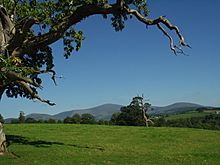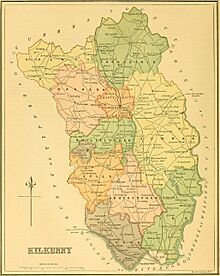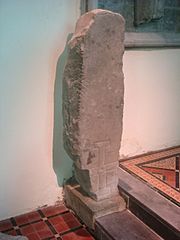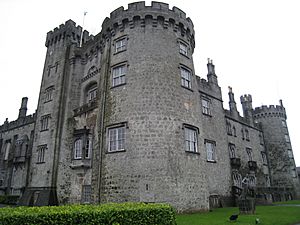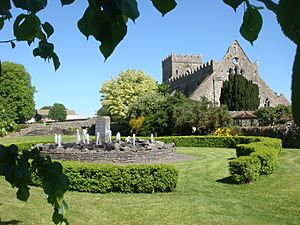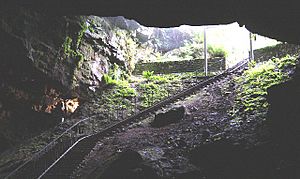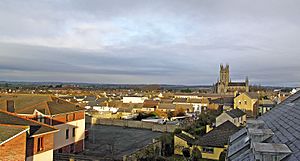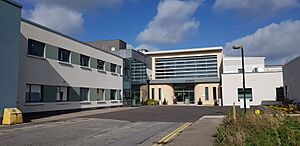County Kilkenny facts for kids
Quick facts for kids
County Kilkenny
Contae Chill Chainnigh
|
||
|---|---|---|
|
||
| Etymology: Named after Kilkenny | ||
| Nickname(s):
The Marble County
|
||
| Anthem: The Rose of Mooncoin | ||
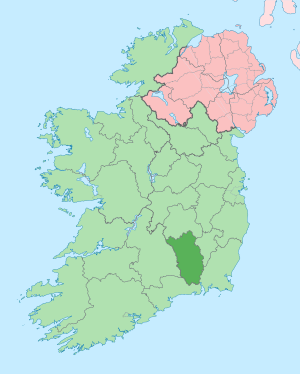
County Kilkenny in Ireland
|
||
| Country | Ireland | |
| Province | Leinster | |
| Region | Southern | |
| Osraige | about 150 | |
| Shire of Kilkenny | after 1172 | |
| Earldom of Ormond | about 1328 | |
| Earldom of Ossory | about 1528 | |
| County of Kilkenny | by 1610 | |
| Founded by | Óengus Osrithe | |
| Named for | St. Canice | |
| City | Kilkenny | |
| Area | ||
| • Total | 2,073 km2 (800 sq mi) | |
| Area rank | 16th | |
| Highest elevation | 515 m (1,690 ft) | |
| Population
(2022)
|
||
| • Total | 103,685 | |
| • Rank | 21st | |
| • Density | 50.017/km2 (129.54/sq mi) | |
| Demonym(s) | Cat | |
| Eircode |
E41, R95 (primarily)
|
|
| Area code(s) | + 353 56 & 353 51 | |
| ISO 3166 code | IE-KK | |
| Number plate | KK | |
County Kilkenny (Irish: Contae Chill Chainnigh) is a county in Ireland. It is located in the province of Leinster in the southeast of the country. The county is named after the city of Kilkenny, which is also its main town and local government center. In 2022, the county had a population of 103,685 people. Kilkenny is known for its rich history, beautiful landscapes, and strong connection to the sport of hurling.
Contents
Discover County Kilkenny
County Kilkenny is the 16th largest county in Ireland by land area. It is the 21st largest in terms of population. In Leinster, it's the third largest by size and seventh by population. About 50 people live in every square kilometer.
Kilkenny shares borders with five other counties. These are Tipperary to the west and Waterford to the south. To the east are Carlow and Wexford. Finally, Laois is to the north. Kilkenny city is about 50 km from Waterford. It is 124 km from Dublin and 150 km from Cork.
Exploring Kilkenny's Nature
Kilkenny has a varied landscape with hills and rivers. The River Nore flows right through the county. The River Suir forms part of its border with County Waterford. The highest point in Kilkenny is Brandon Hill, which is 515 meters (1,690 feet) tall. Most of the county has rolling hills. The middle part is lower than the north, east, and south.
The county covers an area of about 2,073 square kilometers (800 sq mi). It stretches about 45 miles (72 km) from north to south. Its widest part from east to west is about 23 miles (37 km). The narrowest part is about 12 miles (19 km).
Rivers and Waterways
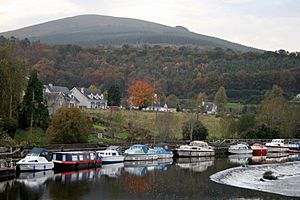
The main rivers in County Kilkenny are called the "Three Sisters". These are the Nore, Barrow, and Suir. The River Nore flows through towns like Ballyragget, Kilkenny City, and Thomastown. The River Suir marks the border with County Waterford. The River Barrow forms part of the county's eastern edge.
Even though Kilkenny is inland, it can reach the sea. This is possible through Belview Port on the Suir Estuary. Also, New Ross on the River Barrow provides sea access. The rivers help drain the land, making the central plains very fertile. Rivers like the Kings River and Dinan are popular for canoeing. The Nore and Barrow are great for fishing and boating.
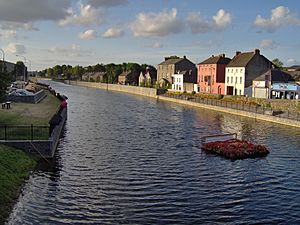
Protected Natural Areas
Kilkenny has special areas to protect its nature. These are called Special Areas of Conservation. They include places like Hugginstown Fen and The Loughans. Cullahill Mountain and Spahill and Clomantagh Hill are also protected. These areas help protect important plants and animals.
In 2005, Coan Bogs became a Natural Heritage Area. This bog is near Castlecomer. It is important for its unique blanket bog plants. Fiddown Island is a Nature Reserve. It is a long, narrow island with marsh and woodland. It is the only place of its kind in Ireland.
Wildlife and Plants
County Kilkenny is home to many different animals. You can find hedgehogs, otters, and badgers. There are also red foxes and several types of bats. Sika deer, fallow deer, and red squirrels also live here. Birds nest from March 1st to September 1st. Woodlands and hedgerows are important homes for wildlife.
Kilkenny also has many special plants. Some rare ones include the autumn crocus and the Killarney fern. There are also vulnerable species like the lesser snapdragon and the meadow barley.
Woodlands and Trees
Kilkenny has many woodlands. Surveys have been done to identify and protect them. About 2.15% of the county is native forested land. Some of the best woodlands for nature are Kylecorragh Wood and Grenan Wood.
The government works to protect trees and woodlands. Laws prevent trees from being cut down without permission. They also protect hedges during bird nesting season. Threats to woodlands include invasive plants and heavy grazing.
Kilkenny has about 180 important trees. These are listed in the Tree Register of Ireland. They are chosen for their age, height, or historical connections. The tallest tree is a silver fir at Woodstock Gardens. The tree with the largest trunk is a common lime at Coolmore House. Some trees are protected by Tree Preservation Orders. These include trees at Castle Gardens and Oldcourt in Inistioge.
Kilkenny's Climate
Kilkenny has a changeable oceanic climate, like the rest of Ireland. This means it has mild temperatures without big extremes. It can have some of the highest summer and lowest winter temperatures in Ireland. The highest temperature ever recorded in Ireland was 33.3°C (91.9°F) at Kilkenny Castle in 1887.
The weather station in Kilkenny recorded its highest temperature at 30.8°C (87.4°F) in 1995. The lowest was -14.1°C (6.6°F) in 1979. The county is generally sheltered from strong winds. This is because it is inland and surrounded by hills.
Kilkenny's Regions and Towns
The county is divided into twelve areas called baronies. These are then split into civil parishes and townlands. There are about 800 townlands in Kilkenny. These divisions are mostly for historical and land purposes now. They are not used for local government anymore.
The baronies include:
- Callan
- Cranagh
- Fassadinin
- Galmoy
- Gowran
- Ida
- Iverk
- Kells
- Kilculliheen
- Kilkenny
- Knocktopher
- Shillelogher
Towns and Villages to Visit
Kilkenny has many towns and villages. Some of these include:
- Ballyhale
- Ballyragget
- Bennettsbridge
- Callan
- Carrigeen
- Castlecomer
- Castlewarren
- Clogh
- Coan
- Danesfort
- Dungarvan
- Dunnamaggan
- Ferrybank
- Freshford
- Galmoy
- Goresbridge
- Gowran
- Graiguenamanagh
- Glenmore
- Hugginstown
- Inistioge
- Jenkinstown
- Johnstown
- Johnswell
- Kilkenny
- Killinaspick
- Kilmacow
- Kilmoganny
- Knocktopher
- Kilmanagh
- Moneenroe
- Mooncoin
- Mullinavat
- Paulstown
- Piltown
- Rosbercon
- Slieverue
- Stoneyford
- Thomastown
- Tullaroan
- The Rower
- Urlingford
- Windgap
A Glimpse into Kilkenny's Past

County Kilkenny gets its name from Kilkenny city. The name Kilkenny comes from the Irish Cill Chainnigh. This means "Church of Cainneach or Canice". It refers to St Canice's Cathedral, built to honor St. Canice.
Kilkenny was once part of the ancient Kingdom of Osraige. The kings of Osraige, the Mac Giolla Phádraig family, ruled this area. The kingdom existed from about the 2nd century to the 13th century AD. The area's church region is still called Ossory. Kilkenny became the main church center in Osraige.
The kingdom was bordered by the rivers Barrow and Suir. Its northern border was generally the Slieve Bloom Mountains. The Osraige people lived in much of modern County Kilkenny. They also lived in parts of County Laois. The River Nore flowed through their kingdom.
In 1154, Pope Adrian IV allowed Norman King Henry II of England to claim Ireland. The Normans arrived in the area around 1155. Jerpoint Abbey was founded in 1158 by Donal MacGiollaPhadruig, King of Ossory. In 1168, Dermot MacMurrough, the King of Leinster, was forced out of his kingdom. He sought help from King Henry II. He got help from a Norman lord named Richard de Clare, 2nd Earl of Pembroke, also known as Strongbow. Strongbow and his army took Wexford, Waterford, and Dublin. Strongbow married MacMurrough's daughter, Aoife, in 1170. Kilkenny became part of the Norman Lordship of Ireland.
Must-See Places in Kilkenny
Kilkenny has many interesting buildings and sites. You can find structures from the Stone Age to modern times. These include Norman castles and Georgian buildings. There are also Gothic cathedrals and country houses.
Ancient Structures
You can find signs of early settlements all over the county. There are large burial mounds called portal tombs and dolmens. These are at places like Owning and Kilmogue-Harristown. Knockroe has a passage grave. These are ancient tombs with a central burial room and a long entrance.
An ancient house was found in Granny, near Waterford. This is the oldest house found in County Kilkenny. It was built around 4000 BC.
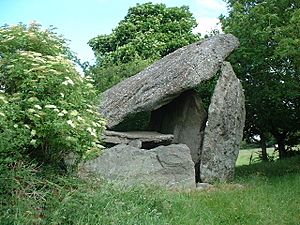
Ogham stones are also found in Kilkenny. These stones have an ancient Irish alphabet carved on them. The Gowran Ogham Stone is a good example. It has carvings from the 3rd or 4th century. A Christian cross was added around the 6th century.
Ireland has thousands of ringforts, or "raths". These are circular forts from the Iron Age. You can find protected ringforts at places like Carigeen and Danesfort.
Round stone towers are a unique feature of early Irish architecture. The tower at St Canice's Cathedral in Kilkenny City is a great example. Other round towers are found at Tullaherin and Aghaviller.
Historic Castles
Kilkenny Castle is a famous castle in Kilkenny. It was once the home of the Butler family. The castle was sold for a small amount of money in the mid-20th century. Now, it is owned by the state and open to visitors. It has beautiful gardens and is a very popular tourist spot.
Foulksrath Castle is a 15th-century Anglo-Norman tower house. It is located in Jenkinstown. The Purcell family built it. After centuries, it was taken by Oliver Cromwell. The Purcell family then lived as peasants in the castle stables.
Abbeys and Priories
Jerpoint Abbey is a Cistercian abbey near Thomastown. It was built in 1180. It is known for its stone carvings. One carving is at the tomb of Felix Ua Duib Sláin, a bishop when the abbey was founded.
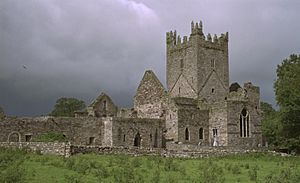
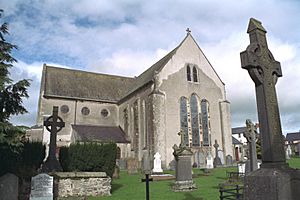
Duiske Abbey in Graiguenamanagh was founded in 1204. It was one of the first and largest Cistercian monasteries in Ireland. Today, a large Gothic church remains. It dominates the town center. You can see original floor tiles and beautiful architecture there.
The Black Abbey in Kilkenny was founded in 1225. It is a Dominican abbey. Kells Priory is one of Ireland's largest medieval monuments. It looks more like a fortress than a church. This is because it has many medieval tower houses. The Callan Augustinian Friary is in Callan. It was founded in 1461.
Historic Bridges and Churches

County Kilkenny has many 18th-century bridges. These bridges are important parts of the county's history. Many were rebuilt after a big flood in 1763. George Smith, a famous designer, created many of them. These include Green's Bridge in Kilkenny and Thomastown Bridge.
Many beautiful churches were built in medieval times. These include St. Mary's Collegiate Church Gowran, St Canice's Cathedral, and St. Mary's Cathedral.
St. Lachtain's Church in Freshford was built in 1731. It uses a portal from an older church built around 1100. This old doorway is all that is left of the original church.
Top Tourist Spots
Some of the best places to visit in County Kilkenny include Jerpoint Abbey and Kells Priory. In Kilkenny City, you can explore St Canice's Cathedral, St Mary's Cathedral, Rothe House, and Kilkenny Castle.
Dunmore Cave is a show cave in Ballyfoyle. It has amazing cave formations. It is also an important archaeological site. Jenkinstown Park is a nice park north of Kilkenny city.
Gardens and Walking Trails
Kilkenny has many beautiful gardens. These include Kilfane Glen in Thomastown and Woodstock Garden in Inistioge. The Discover Park in Castlecomer is also a great place to visit. The rose garden at Kilkenny Castle is very popular.
The Nore Valley Way is a long walking trail. It starts in Kilkenny City and ends in Inistioge. It is a great way to explore the county's scenery. The South Leinster Way is another scenic trail. It follows the Barrow Valley and goes near Brandon Hill.
Kilkenny's People and Culture
In 2016, County Kilkenny had a population of 99,232 people. About 38,722 people reported speaking some Irish language. Most people in Kilkenny are Catholic. However, there are also other religious groups.
The Irish Language in Kilkenny
County Kilkenny was one of the last counties in Leinster to have native Irish speakers. The Irish spoken here was similar to the dialect in County Waterford. One special feature was how the "slender R" sound was pronounced.
Pádraig Paor from Baile Shéamais in Glenmore is believed to be the last traditional native Irish speaker in County Kilkenny. Recordings of his speech were made in 1936.
Local Economy
In 1966, local creameries in Kilkenny joined together. They formed Avonmore Creameries. This company later became Glanbia plc, a large international nutrition company. In 2022, the local operations returned to co-operative control under the Tirlán brand.
Getting Around Kilkenny
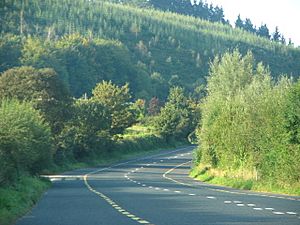
Transport Options
Iarnród Éireann (Irish Rail) provides train services. You can travel from Dublin to Waterford through Kilkenny. Trains stop at Kilkenny MacDonagh Station and Thomastown railway station. There are services every two hours.
Bus Éireann and JJ Kavanagh and Sons offer bus services throughout the county. Kilkenny Airport is a small airport. It is located just west of Kilkenny city.
Healthcare in Kilkenny
County Kilkenny has several hospitals. St. Luke's General Hospital is a public hospital. It offers general medical and surgical services. St. Canice's is a psychiatric hospital. It provides mental health services. Kilcreene is a regional hospital for bone and joint problems. Aut Even is a private hospital. There is also Castlecomer District Hospital in Castlecomer.
Most maternity services for Kilkenny are provided at University Hospital Waterford. Health centers are also located in many towns and villages across the county.
Sports in Kilkenny
Hurling: Kilkenny's Passion

Hurling is the most popular sport in County Kilkenny. The Kilkenny GAA team is very successful. They have won the All-Ireland Senior Hurling Championship a record 36 times. They have also won the Leinster Senior Hurling Championship 70 times. Kilkenny is known as one of the "Big Three" in hurling, along with Cork and Tipperary.
The Kilkenny team wears black and amber colors. The Tullaroan team was the first to wear these famous colors in 1886.
Horse Racing and Golf
Gowran Park is a horse racing course near Gowran. It hosts 16 race days each year. One of its most famous races is the Thyestes Chase. This race has been won by famous horses like Arkle.
Mount Juliet Golf Course is a well-known golf resort. It has hosted major golf tournaments. The course was designed by Jack Nicklaus. Kilkenny Golf Club is another 18-hole course near the city. It has also hosted professional events. Other golf courses in the county include Gowran Park Golf Course and Callan Golf Club.
Kilkenny's Culture
The TV show The Riordans (1965-1979) was set in a fictional townland in County Kilkenny. It was one of the first Irish soap operas to film outside the studio. It even inspired the British show Emmerdale.
County Anthems
The song "The Rose of Mooncoin" is the traditional anthem for County Kilkenny. It is often sung at GAA games. Another song, Kilkenny by the Nore, is also becoming a popular anthem.
Famous People from Kilkenny
Many notable families have lived in Kilkenny. These include the Agar family of Gowran and the Blunden family of Castle Blunden. Other famous families are the Butler (Earls of Ormonde) and the Cuffe (Lords Desart).
See also
 In Spanish: Condado de Kilkenny para niños
In Spanish: Condado de Kilkenny para niños
Images for kids



